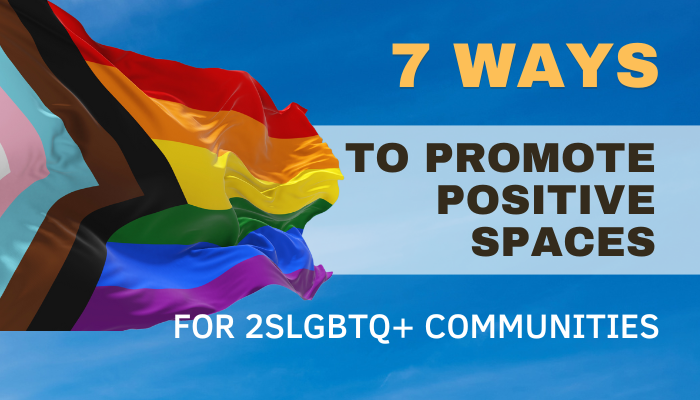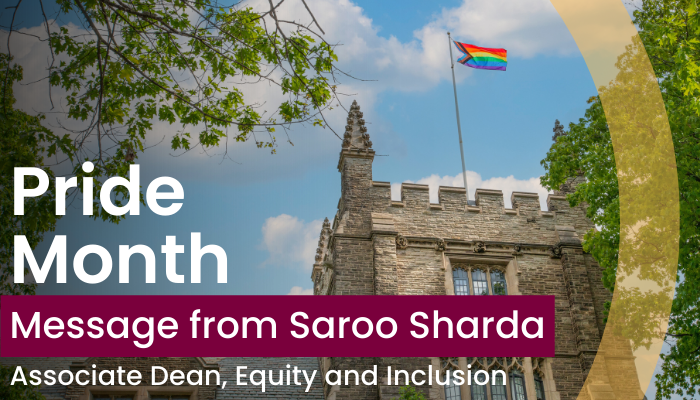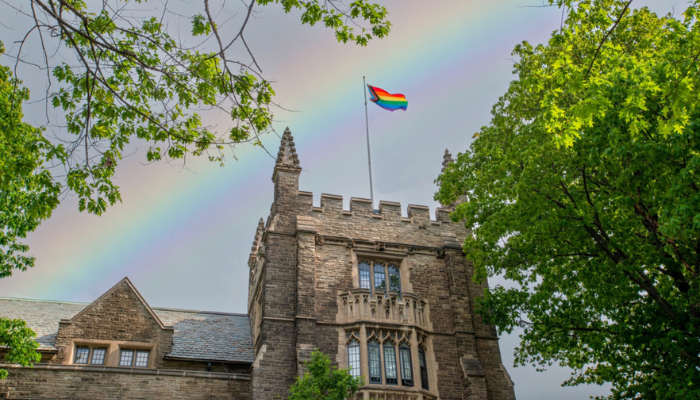7 ways to help promote positive spaces for 2SLGBTQ+ communities

Pride Month is a time to recognize the importance of equality and promoting safe and supportive spaces for all.
Creating positive spaces for people who identify as 2SLGBTQ+ is crucial as it fosters acceptance and inclusivity. These spaces are places where individuals can feel welcomed and supported.
To help you create those safe places, here are seven ways to promote positive spaces for 2SLGBTQ+ communities.
1. Reflect on your use of language.
Educate yourself on current language being used within 2SLGBTQ+ communities to describe various sexual orientations and gender identities. Use inclusive language and reflect back the language used by the person you are communicating with. Do not make assumptions about a person’s sexual orientation or gender identity.
Words matter and they are powerful. Terminology related to sexual orientation and gender identity is evolving and it can be challenging to try to “keep up” with the latest terminology in this area. It is important to use language that is based on a person’s understanding of themselves rather than language based on assumptions. Using language that is gender inclusive and inclusive of various relationship statuses is an important endeavor. It is also imperative that while you are following an individual’s lead (i.e., using their stated name and pronouns), you do not expect them to educate you. Instead, continue to educate yourself on any gaps in knowledge you may have about sexual orientation and gender identity.
2. Post a non-discrimination policy that includes sexual orientation, gender identity and gender expression.
Developing and displaying non-discrimination policies that reflect 2SLGBTQ+ inclusion demonstrates a commitment to 2SLGBTQ+ human rights. This non-discrimination policy should be posted in several high-profile physical (e.g., at the entrance of an office, lab or workspace, etc.) and virtual locations (e.g., on a website and social media, in a newsletter, etc.).
3. Offer gender-inclusive bathrooms, when possible.
Offering gender-inclusive bathrooms demonstrates inclusion for everyone. If this is not possible, given constraints of the physical environment, then policies related to bathrooms should be posted and enforced, indicating that everyone should use the bathroom that best aligns with their gender identity.
4. Display posters, pamphlets and/or signs that are inclusive of 2SLGBTQ+ people and issues.
It is important to demonstrate public acceptance for people who, traditionally, may experience bullying, violence, discrimination, heterosexism, cisgenderism, homophobia, biphobia and/or transphobia and who may experience rejection and lack of support from friends and family. Public signs of acceptance tell an individual that they are safe to be who they are in this environment. It is crucial to ensure the message is actually true. Creating a positive space requires more than simply placing a rainbow sticker on an office or lab door, it requires actions that demonstrate to 2SLGBTQ+-identified people that their identity and their concerns are important and that they will be treated with respect and dignity.
5. Speak up when you see discrimination, insensitivity and/or gaps in knowledge or action.
Speaking up and potentially calling out colleagues and others when you witness instances of discrimination, insensitivity or inaction can be very challenging and uncomfortable. However, this is a crucial component in being an ally to the 2SLGBTQ+ community. Allyship requires practice and should be treated as a skill that can be developed. Frameworks exist that can assist you in how to intervene in such situations. To learn more, refer to this article by Saroo Sharda et al.
6. Seek out knowledge on affirming 2SLGBTQ+ identities.
Many people do not receive sufficient training or education related to 2SLGBTQ+ identities in school or in the workplace. There are many opportunities available for further education on this topic, including the resources listed below. Receiving positive space training and/or education on issues related to 2SLGBTQ+ identities is important for all the spaces in which you live and work.
7. Accept and celebrate diversity.
Some people adopt a neutral position on the issue of a person’s sexual orientation and/or gender identity/expression, believing that these issues do not or should not affect how they communicate with them. However, “neutrality” can equate to dismissiveness, as this stance does not take into account an important part of a person’s identity and life experiences. The message that may be received by 2SLGBGTQ+ people is that you may not be interested in engaging in conversations with them about issues related to their sexual orientation and/or gender identity such as problems they might be having in their relationships, homo/bi/transphobia and/or issues related to coming out.
Resources:
- Rainbow Health Ontario
- Sherbourne Health Guidelines (PDF)
- Trans Primary Care Guide
- World Professional Association for Transgender Health (WPATH)
- WPATH Standards of Care, Version 8 (PDF)
- National LGBTQIA+ Health Education Center
- Hamilton Family Health Team Positive Space
- Microaggressions in anesthesiology and critical care by Saroo Sharda et al
2SLGBTQ+ is an acronym for Two Spirit, Lesbian, Gay, Bisexual, Transgender, Queer, and represented by the + sign, other diverse minority sexual orientations and gender identities.
This article was written by Albina Veltman MD, FRCPC, associate chair of Equity, Diversity, Inclusion and Indigenous Reconciliation (EDI & IR) and associate professor in the Department of Psychiatry & Behavioural Neurosciences.
Equity, Diversity & Inclusion NewsRelated News
News Listing

Pride Month message from Saroo Sharda, associate dean of equity and inclusion
Equity, Diversity & Inclusion News
June 3, 2024

Daily News ➚
National Indigenous History Month: a time for education and reflection
Equity, Diversity & Inclusion News, Indigenous Health
June 1, 2023

June 1, 2023
